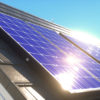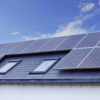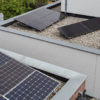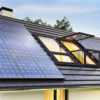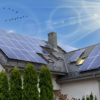If you’ve been considering installing solar panels at home, now is the time to act! With the federal solar rebate (‘STC scheme’) now being phased out, you’ll want to get your solar power system installed before the rebate is gone.
Installing a solar panel system at home can help you reduce your energy bills, minimize your carbon footprint, and lower your dependency on the power grid. Once you have a system in place and you’ve recouped your initial investment, you could potentially have decades of free electricity generated by the sun. However, installing an efficient system at home requires more than just purchasing solar panels. Here’s what else you’ll need to install solar panels at home.
What Equipment Is Needed for Solar Panels?
When it comes to solar panel systems, the panels themselves are just part of the equation. Additional equipment including inverters, racking systems, tracking systems, and batteries are required to get the most out of your investment.
Solar Inverter
Most home appliances and electrical systems require AC electricity, yet solar panels produce DC electricity. This means that to use the electricity produced by your panels, you’ll need to install a solar inverter. There are three different solutions to choose from:
- String inverters (also known as centralized inverters): Most affordable solution but inefficient with any shade due to potential production loss.
- Micro inverter: Smooth operation even in shading and are installed on each panel but improved efficiency comes with a higher price tag.
- Power Optimizers: Installed on each panel to optimize DC output before sending to a string inverter for conversion into AC current. This is a good solution when a micro inverter is out of your budget.
These inverters also help keep your power from going to the grid during power outages and feature safety shutoffs to protect your solar panels and your home’s wiring. Depending on which type of inverter you choose, they’ll typically last between 10-25 years.
Note that the cost of your solar panel inverter could be offset by the STC scheme, given that it is one that is approved by the Clean Energy Council for use in Australia and your system meets size restrictions and installation requirements.
Racking System
A common misconception when it comes to installing solar power systems at home is that the panels are attached directly to the roof. The reality is that solar panels actually need to be mounted on a racking system.
There are four main components to a racking system: flashing, mounts, rails, and clamps.
- Flashing: Inserted under the shingles, flashing prevents leaking where the racking system is installed in the roof.
- Mounts: These are the actual “feet” of the racking system where the racking system attaches to the roof and rafters.
- Rails: Tracks that run along the length of your roof where your solar panels will rest.
- Clamps: This component holds your panels in place on the racking.
These systems are typically made from aluminium and simply hold the solar panels in place. Racking systems also allow panels to be angled to optimize the amount of sun exposure they receive. You can also get racking systems for ground mount solar power systems as well as solar carports.
Performance Monitoring and Tracking System
Installing a performance monitoring and tracking system is the best way to make sure your system is functioning properly at all times. Most solar performance monitoring systems will track your energy consumption, solar electricity production, grid imports and exports, and the amount of charge in your solar battery. Many systems will send this information to a website or an app where you can monitor in real-time.
Many homeowners will stay hooked up to the power grid so that they can sell the additional electricity their panels produce and to serve as a backup should their solar power system fail for any reason. Without a way to monitor the performance of your solar power system, you could be in for a nasty surprise. By getting alerts when performance declines, you can investigate as to what the problem is and rectify it before your energy bill rises dramatically.
Some solar inverter manufacturers offer monitoring software that will alert you in the case that your system fails entirely. However, if you want a detailed analysis of your solar power system’s performance, you’ll want to invest in a separate performance monitoring and tracking system.
Battery Storage
Once you can track that your system is working efficiently, what do you do with the extra energy your panels produce? While you can often sell it to the grid, you’ll want to have a backup of your own. This means it’s essential to have solar battery storage to give you power on those cloudy days and at night. There are several different types of solar batteries you can choose from depending on your budget and needs:
- Lithium-ion. This type of battery is similar to what you’ll find in your phone or laptop, with the most iconic being the Tesla Powerwall. This is the most popular choice for home energy storage given their cycle life and lifespan of around 13-18 years and 80% depth of discharge. However, they are currently expensive (although this will change as more electric vehicles come to market).
- Lead-acid. This is the same type of battery you use in your petrol or diesel vehicles. While these batteries work, they are bulky, need to be in a climate-controlled environment to maximize their lifespan, they have low cycle life (typically lasting 2-8 years), and a depth of discharge of <60%.
- Sodium Nickel Chloride. These batteries compete directly with lithium-ion batteries with their 80% depth of discharge. While they work in a wider range of environments and do not require an internal cooling system, they have a significantly lower cycle life.
- Flow. This is a more recent technology being used with home energy storage. It is a battery that has liquid electrolytes that flows between two tanks through a membrane and then through electrochemical cells. It has a 100% depth of discharge and a higher cycle life than other batteries on the market. Because this technology is still developing this is currently the most expensive option available.
Installing Your Solar Panel System
If you want your system to work as efficiently as possible, you’ll need this additional equipment regardless of the size of your project. However, it is recommended that you work with a CEC-accredited installer or a Smart Energy Council Master Installer when it comes to installing your system, even the peripheral equipment. Not only will this save you the trouble, but it will help make sure you can take advantage of the STC scheme which requires you to use a certified installer. You can find a list of accredited installers in your area here. And remember, always be sure to get proof of accreditation before you begin your project!

